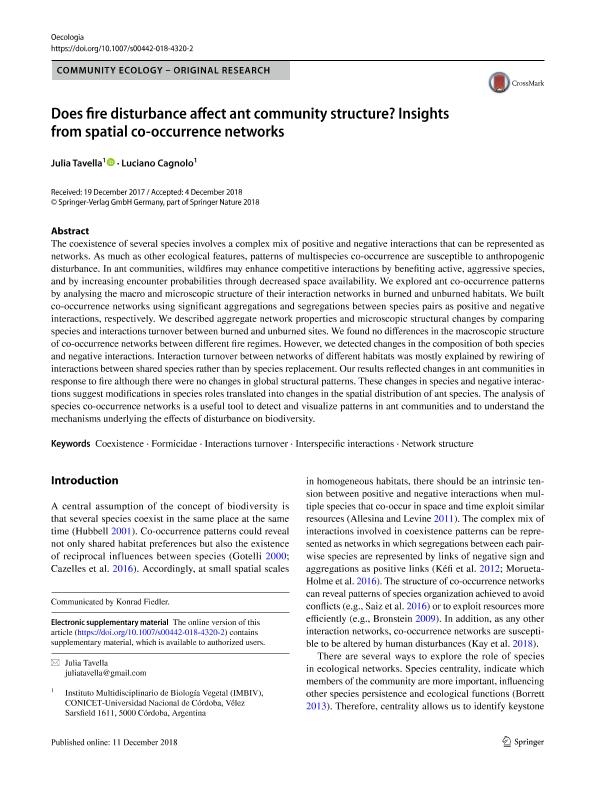Mostrar el registro sencillo del ítem
dc.contributor.author
Tavella, Julia Rita

dc.contributor.author
Cagnolo, Luciano

dc.date.available
2020-07-14T17:11:37Z
dc.date.issued
2018-12
dc.identifier.citation
Tavella, Julia Rita; Cagnolo, Luciano; Does fire disturbance affect ant community structure? Insights from spatial co-occurrence networks; Springer; Oecologia; 189; 2; 12-2018; 475-486
dc.identifier.issn
0029-8549
dc.identifier.uri
http://hdl.handle.net/11336/109237
dc.description.abstract
The coexistence of several species involves a complex mix of positive and negative interactions that can be represented as networks. As much as other ecological features, patterns of multispecies co-occurrence are susceptible to anthropogenic disturbance. In ant communities, wildfires may enhance competitive interactions by benefiting active, aggressive species, and by increasing encounter probabilities through decreased space availability. We explored ant co-occurrence patterns by analysing the macro and microscopic structure of their interaction networks in burned and unburned habitats. We built co-occurrence networks using significant aggregations and segregations between species pairs as positive and negative interactions, respectively. We described aggregate network properties and microscopic structural changes by comparing species and interactions turnover between burned and unburned sites. We found no differences in the macroscopic structure of co-occurrence networks between different fire regimes. However, we detected changes in the composition of both species and negative interactions. Interaction turnover between networks of different habitats was mostly explained by rewiring of interactions between shared species rather than by species replacement. Our results reflected changes in ant communities in response to fire although there were no changes in global structural patterns. These changes in species and negative interactions suggest modifications in species roles translated into changes in the spatial distribution of ant species. The analysis of species co-occurrence networks is a useful tool to detect and visualize patterns in ant communities and to understand the mechanisms underlying the effects of disturbance on biodiversity.
dc.format
application/pdf
dc.language.iso
eng
dc.publisher
Springer

dc.rights
info:eu-repo/semantics/openAccess
dc.rights.uri
https://creativecommons.org/licenses/by-nc-sa/2.5/ar/
dc.subject
COEXISTENCE
dc.subject
FORMICIDAE
dc.subject
INTERACTIONS TURNOVER
dc.subject
INTERSPECIFIC INTERACTIONS
dc.subject
NETWORK STRUCTURE
dc.subject.classification
Ecología

dc.subject.classification
Ciencias Biológicas

dc.subject.classification
CIENCIAS NATURALES Y EXACTAS

dc.title
Does fire disturbance affect ant community structure? Insights from spatial co-occurrence networks
dc.type
info:eu-repo/semantics/article
dc.type
info:ar-repo/semantics/artículo
dc.type
info:eu-repo/semantics/publishedVersion
dc.date.updated
2020-07-13T16:11:08Z
dc.identifier.eissn
1432-1939
dc.journal.volume
189
dc.journal.number
2
dc.journal.pagination
475-486
dc.journal.pais
Alemania

dc.description.fil
Fil: Tavella, Julia Rita. Consejo Nacional de Investigaciones Científicas y Técnicas. Centro Científico Tecnológico Conicet - Córdoba. Instituto Multidisciplinario de Biología Vegetal. Universidad Nacional de Córdoba. Facultad de Ciencias Exactas Físicas y Naturales. Instituto Multidisciplinario de Biología Vegetal; Argentina
dc.description.fil
Fil: Cagnolo, Luciano. Consejo Nacional de Investigaciones Científicas y Técnicas. Centro Científico Tecnológico Conicet - Córdoba. Instituto Multidisciplinario de Biología Vegetal. Universidad Nacional de Córdoba. Facultad de Ciencias Exactas Físicas y Naturales. Instituto Multidisciplinario de Biología Vegetal; Argentina
dc.journal.title
Oecologia

dc.relation.alternativeid
info:eu-repo/semantics/altIdentifier/url/https://link.springer.com/article/10.1007/s00442-018-4320-2
dc.relation.alternativeid
info:eu-repo/semantics/altIdentifier/doi/https://doi.org/10.1007/s00442-018-4320-2
Archivos asociados
